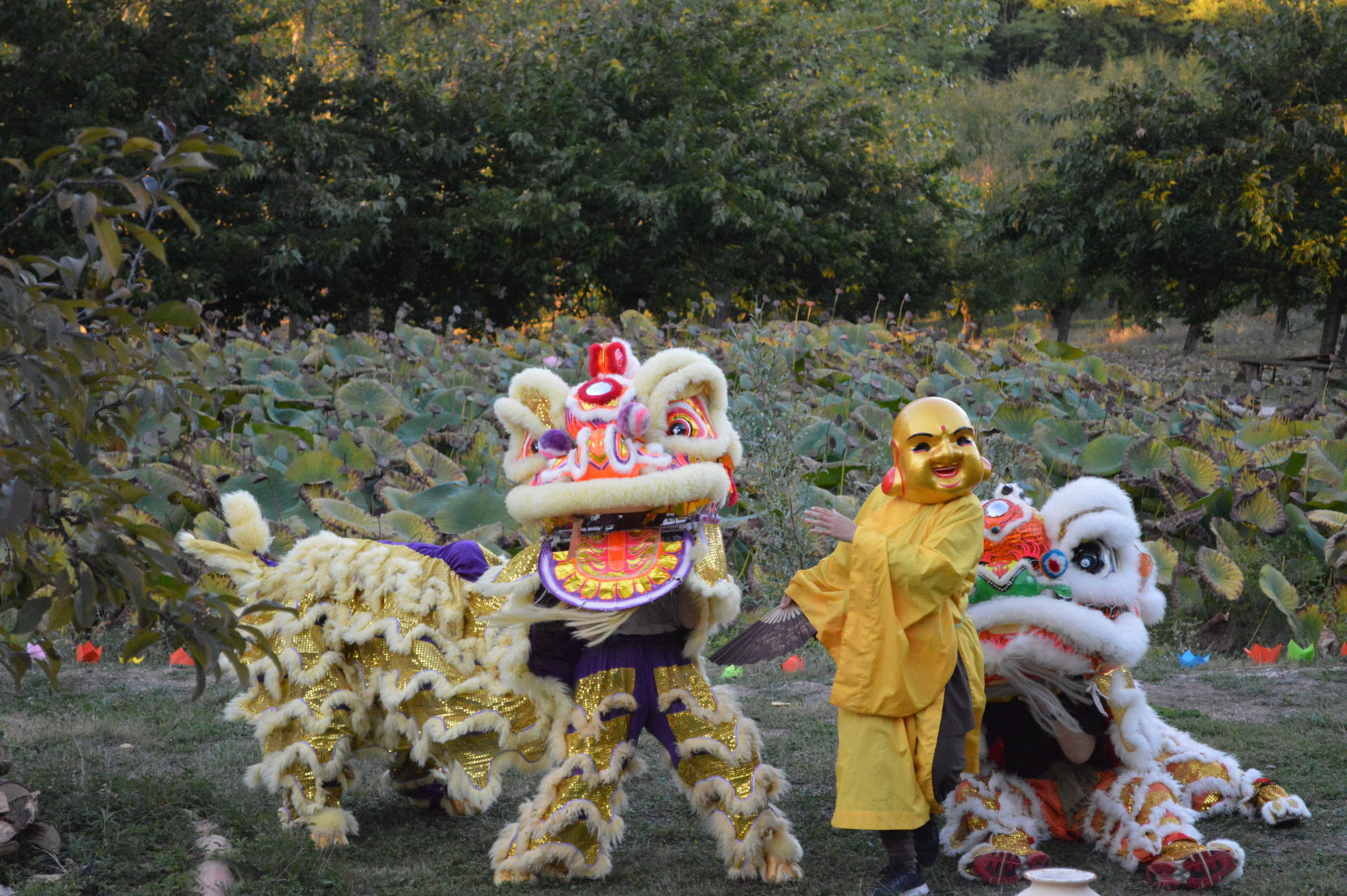By Jaime Robeck

It is a lovely spring evening. The meditation hall is silent as each practitioner makes the last adjustments to their cushion or chair. In this quiet moment, the birds make their debut. Their sweet voices enter the building and rise to fill the large space of the meditation hall. They are accompanied by the spring peepers’ faint call that has begun to check in for their evening songs.
By Jaime Robeck

It is a lovely spring evening. The meditation hall is silent as each practitioner makes the last adjustments to their cushion or chair. In this quiet moment, the birds make their debut. Their sweet voices enter the building and rise to fill the large space of the meditation hall. They are accompanied by the spring peepers’ faint call that has begun to check in for their evening songs. I embrace these beautiful sounds around me. I feel peaceful. I feel calm. The evening chant begins and, with a breath, we begin moving together into our meditation.
In the next moment, someone swings open the door to the meditation hall and allows it to slam shut behind them. Even if I were inclined to turn my body to see the transgressor, I wouldn’t need to. I already know who it is. She moves across the room with a force one wouldn’t expect from such a small body. Her keys clank in her pockets as she rattles her way over to grab a chair, which she then drags over the full length of the lovely wooden floor. Throughout the meditation she shifts, coughs, and takes long, loud sips from her Styrofoam coffee cup. I can feel my frustration mount as my thoughts circle into a dark cloud of negativity.
The peace and calm I felt moments ago have degraded into a relentless deluge of thoughts and stories: “This is my time. This is my time to have a little bit of quiet. Can’t my evening, even just this one hour of this one evening of my week be silent?” My shoulders begin their trek up to my ears; my brow furrows and my stomach tightens as the internal thought storm ensues, “She isn’t even trying to be quiet! Someone needs to let her know that her actions are interfering with our practice. She’s not just ruining my meditation; she’s ruining this evening for everyone.”
A feeling of dread grips me as my thoughts turn toward our Dharma discussion. I love this time of sharing together as a Sangha, but when she’s here no one gets a chance to share. She talks out of turn and has even been known to verbally attack other members when they share. She has little tolerance for the rules that govern our discussion format. I wonder how I will endure the rest of the evening when the buzz from her cell phone calls me back to the present moment.
This is how the first months and years played out for me as I struggled to find my balance. I built up stories and enlarged offenses until they were bigger than I could manage. The frustration was built around these situations I couldn’t control. Though, I did try to control them. I made efforts to communicate my desire for a certain behavior to change in a lighthearted way but only to find a new, more offensive behavior creep up in its place.
Other equally exasperated Sangha members found the same repeated pattern when they made effort to communicate these problems to the perceived offender. My meditation experience devolved into a time of creating stories and feeding frustrations. This wasn’t what I wanted. I had been at this practice long enough to know I had a choice. I could leave the Sangha or take some responsibility. I may not have been able to change her behavior, but I could choose to stay and embark on a path to change mine. The path I ultimately chose went from questioning, to nurturing a small seed of appreciation, to finally settling into a place of transformation.
My first experience with a shift came from gently asking myself a question: Are you right about her? I had taken great care and devoted much time in creating the stories about her, but was I certain they were true? The question led me to a vast space of uncertainty. I wasn’t sure. I told myself she was there to ruin everyone’s meditation, to be noisy, and to be disruptive to be noticed and get attention. This was my story, but in that space of uncertainty, an openness arose in me and allowed me to grasp an essential element: to be noticed. Wanting to be noticed, and to be cared about and cared for—that is something I could relate to. I know what it’s like to be hurting and in need of attention, care, and kindness.
Suddenly, I didn’t feel different from her. By recognizing this similarity, I could look to myself for answers. What would I need from the people I’ve chosen to surround myself with? What would I need if I felt like everyone was angry with me, and I refused to see or couldn’t see why? I would need someone to show me kindness. I would want someone to appreciate me. How could I show her kindness? How could I learn to see what she offered our Sangha?
This was the first time I had ever considered looking for something to appreciate in her, and when I looked, it was there. I recalled the warm welcome she had extended to my husband and me when we first began to meditate with our Sangha. She extends this welcome again and again with each new person who comes through our doors. She has many wonderful qualities I can see now, but during my frustration, I could only find this one quality. One was all I needed. Just like the seed watering that is part of this practice, that tiny seed of gratitude—when properly tended and cared for—grew into something I could lean into when actions I found disagreeable challenged me.
After many months of practice, a change in my reaction to her behavior took place. A softness formed around what was once so rigid. When her actions challenged me, I soothed my frustration by surrounding it with that spark of appreciation I felt for her. I saw how important it was to protect and nourish this fragile new bloom of appreciation I was tending. To protect such delicate growth, I found it important to disengage from unsupportive negative thoughts. It became absolutely essential for me to separate myself from any community gossip that didn’t aim to solve problems with her or move the community towards more understanding and compassion.
I have many friends in this practice I can relate to with ease. Their ideas and interpretation of the Dharma make it effortless to be in their company. Though I have deep respect for their practice and they inspire me greatly, I have learned much more about my own practice from the people whose behavior challenges me the most. I now recognize that my frustration with another Sangha member is a sign of my own incomplete view and lack of understanding. I always have a choice. I can leave the Sangha or move in closer to the source of my irritation and discomfort to gain a more complete view.
It’s tempting to think we can change people to make them fit into our community and fantasize that this would be the best solution for everyone. But if they could change, they would. It seems that those who insist on creating discord need the Sangha more than any of us. They need someone to show them what kindness and compassion look like, so they can move beyond the suffering they create for themselves and others. My community member may not be stable enough in her practice to begin a path towards change, but I am; my Sangha is my practice ground. The people in the Sangha who have challenged me to move deeper into my practice are a gift. Though it is rarely enjoyable to be challenged in this way, it is always valuable.
Last week as the evening chant began, I heard the door to the meditation hall swing open. I didn’t turn to look. I already knew who it was, and I smiled. As she made her way to her seat, with keys jangling and a plastic water bottle crackling over and over again in her hand, it sounded just as loud to me as ever. I took a breath and imagined the sound of her entry being no different from the sweet call of the birds and the soft sounds of the spring peepers I heard beyond the door. She has arrived. My teacher is here, and I remain in this community to learn.

Jaime Robeck has been practicing with Being Peace Sangha since 2011. She lives with her husband and three children in southern Ohio, US.

